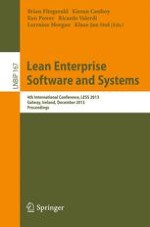This book contains the refereed proceedings of the 4th International Conference on Lean Enterprise Software and Systems, LESS 2013, held in Galway, Ireland, in December 2013.
LESS fosters interactions between practitioners and researchers by joining the lean product development and the agile software development communities in a highly collaborative environment. Each year, the program combines novelties and recent research results that make new ideas thrive during and after the conference. This year, the conference agenda was expanded to incorporate topics such as portfolio management, open innovation and enterprise transformation.
The 14 papers selected for this book represent a diverse range of experiences, studies and theoretical achievements. They are organized in four sections on lean software development, quality and performance, case studies and emerging developments.
